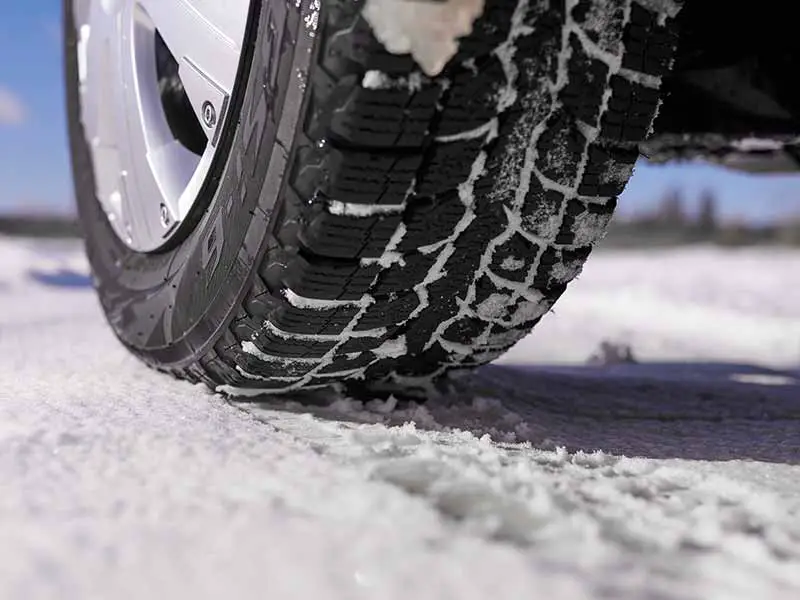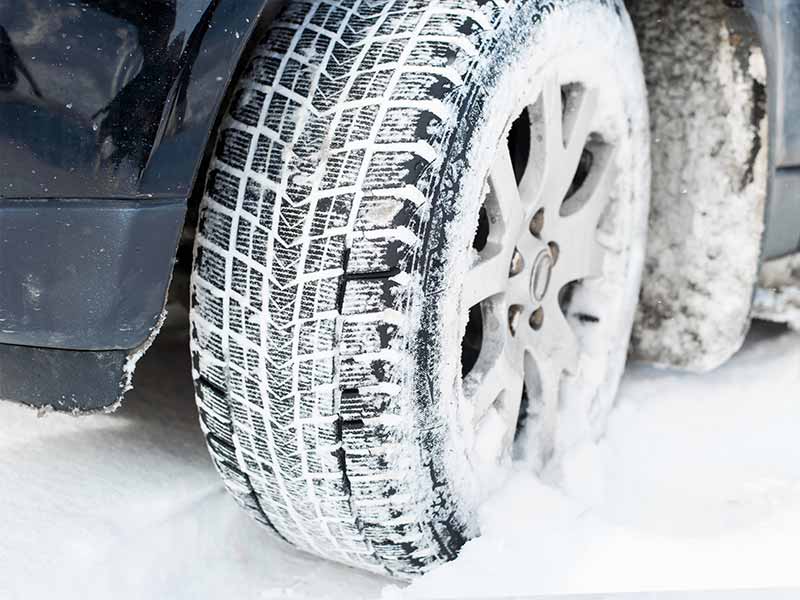Winter snow tires can help improve traction on snow covered roads when compared to other types of tires such as all-season tires. They will also improve traction on dry pavement in winter months and help prevent hydroplaning due to ice melt from heavy snowfall.
They can’t work miracles though. Compact snow will still be challenging and icy roads will be treacherous without studs or chains.
What Are Winter Tires?
Winter tires are specially designed tires to deal with cold temperatures, snow, and ice. Design features include optimized rubber compounds, deeper tread depths, and sipes that create more biting edges. All increase traction in winter weather conditions.
Installing winter tires make sense for drivers in colder climates that frequently see temperatures at or below freezing, snowy conditions, or icy and slushy conditions. But are they the best choice for you?
Let’s take a closer look.

Michelin X-Ice Xi3 Winter
Pros And Cons Of Winter Tires
There is no perfect tire obviously. All tires are designed for different conditions and have to make tradeoffs to properly balance the benefits when compared to the disadvantages that the optimizations required will affect.
It’s important to keep the expectations of their performance reasonable though. Without studs or chains, they won’t be able to grip on ice and will struggle for snow traction when snow is compact and icy.
Also, front wheel drive vehicles will never be able to achieve the same abilities as an all wheel drive car or truck by simply adding winter snow tires. The same is true of a rear wheel drive car or truck.
The pros outweigh the cons when used for their intended purpose.
Benefits Of Winter Tires
- Use of a rubber compound that won’t freeze or lose flexibility in freezing temperatures
- Deeper tread depths that are better able to deal with snow and slush
- Tread blocks with multiple sipes that create many biting edges which increase grip
- Improved winter hydroplane resistance from excessive melt
- Narrower widths that help tires cut through snow and ice slush instead of rolling on top of it
Disadvantages Of Winter Tires
- Shorter tire life due to softer compound tires that wear down more quickly
- Inability to be used safely in warmer weather due to the deeper tread depths combined with extremely soft rubber
- Will require storing during summer months and should be kept away from heat and direct sunlight
- While not required, many purchase wheels specifically for their winter tires to make swapping more convenient and allow them to alter the size of the tire

Winter Tires Vs All-Season
All-season tires are designed to work well through all seasons. They can handle warm weather as well as cold weather that reaches temperatures down to 45º F.
Once below the temperature drops below 45º F, they begin to lose flexibility and the rubber comes hard and rigid. This reduces traction since the rubber can no longer mesh with the asphalt as well and grab the road surface.
A winter tire uses a rubber designed to remain soft and grippy in extreme cold temperatures. While not suitable for warm weather, this softer compound helps your car or truck maintain superior handling and excellent braking performance in the cold.
All-season tires are designed to be able to handle light snow but are not well suited for deep snow and ice covered surfaces. Even good winter tires require care when driving in these conditions, but the tread design is not optimized to properly shed snow and slush as efficiently. Winter tires also are designed with significantly more biting edges to enhance traction in winter conditions.
Winter Tires Vs Summer Tires
As the names imply, these tires couldn’t be more different from each other. Winter tires are specifically designed for cold temperatures while summer tires are specifically designed for warm weather situations. But this isn’t the whole story.
Summer tires are generally performance oriented tires designed to provide maximum wet and dry traction. They’re great year round performance tires if you never seen temperatures drop below 40º F in your area.
Otherwise, they are a seasonal tire that will need to be swapped out when winter weather begins to set in.
Performance tires aren’t only for performance vehicles. Performance means improved handling and braking performance which means improved safety.
Winter tires are best when used in temperatures below 45º F. As temperatures rise beyond this point the soft rubber becomes far too soft and the tall tread blocks flex widely and are unable to properly grip the pavement.
The soft compound will also begin to wear down much more rapidly than when within its ideal temperature range.
Summer tires have soft compound rubber, but not nearly as soft as winter tires. You may think a summer tire with its softer rubber could handle colder temperatures more effectively than an all-season tire, but this couldn’t be further from the truth.
The rubber formulation, while soft, actually begins to freeze and crack in summer tires when the temperatures drop too low. This is obviously quite bad for the tire and terrible for traction and tire life.

Winter Tires Vs All-Weather Tires
All-weather tires are actually a subset of all-season tires. An all-weather tire is simply an all-season tire that is more oriented toward cold conditions than a typical all-season tire.
It shares tread rubber and designs closer to that of a winter tire and can handle winter weather better than all-season tires.
It isn’t as capable as winter tires and isn’t ideal for more extreme winter weather conditions. It’s a good choice for those that have found traditional all-season tires to struggle in winter but don’t have the need for the more extreme winter tires that can’t be used year round.
A good all-weather tire can be used year round and still handle a little more snow and slush. It won’t be great for more extreme cold or packed snow since it is optimized for better traction on asphalt surfaces and not more slippery packed snow.
Winter Tires Vs Snow Tires
Tire manufacturers don’t brand tires as “Snow” tires. Typically, when the term snow tires is used it actually means winter tires.
The confusion likely comes from the mountain and snowflake icon found on a winter tire that meets a standard set by the US tire manufacturer association and Rubber Association of Canada.
The standard to meet the requirements to be authorized to display the three peak mountain snowflake symbol on a tire sidewall is determined by the tire’s ability to maintain traction on snow when compared to a reference tire.
If the tire meets the requirements it will be authorized to display this insignia.
Winter Tires Vs Studded Tires
Winter tires are designed to work well on packed snow. Studded tires are tires that are designed to work well on icy roads.
Studded tires will still have many of the benefits of traditional winter tires, but they are optimized for areas that often have ice-covered roads, such as those along northern coastlines.
Studded tires are very aggressive and can be damaging to normal road surfaces. Some areas will not allow studded tires to be used so you should check your local laws before purchasing a set and attempting to use them.
Even the best winter tires will struggle for traction on hard-packed snow. On ice, they won’t provide much additional benefit at all.
Studded tires significantly improve traction on hard-packed snow and provide meaningful traction on ice-covered roads.
Winter Tires Vs Chains
Like studded tires, chains provide significantly improved traction on hard-packed snow and ice. Tire chains are a great alternative to studded tires, especially if your need for them is only occasional.
Studded tires are quite expensive, especially when compared to chains. You can use your winter tires for the majority of the winter and put chains on in situations where you need the added traction.
They’re usually reasonably easy to install and can be kept in your trunk or hatch so you have them at the precise moment you need them most.
Studded tires are better suited for environments that see extended periods of ice-covered roads with extremely poor traction with traditional winter tires.
Winter Tires Vs All-Terrain Tires
All-terrain tires, even those rated for snowy and icy conditions, are still best suited for those that spend a large portion of time off-road.
A purpose-designed tire for winter weather that is meant for winter road surfaces is going to perform best for those types of conditions.
All-terrain tires will still struggle to gain traction on icy roads and hard-packed snow. But they will be able to deal better with a more uneven surface than pavement much better.
If you will be spending your time on road, buy an on-road tire. If you happen to have some all-terrain tires that are rated for snow and winter temperatures, that should perform adequately but will not be ideal.
Can Winter Tires Be Used In Summer?
Winter tires are dangerous to be used during summer months except in extremely cold climates that rarely see temperatures rise above 45º F.
As temperatures rise above 45º F the rubber used in winter tires becomes extremely soft and the tread blocks will no longer be able to properly hold their shape. While they may feel fine during normal driving in hot weather, this causes cornering and braking performance to become drastically reduced at their limits. This means that emergency braking and maneuvers will quickly push them beyond their capabilities.
The extremely soft compound formulations used will cause the rubber to wear down much more quickly than normal. Due to the cost of winter or snow tires, this can be an expensive mistake.
Winter Tires Temperature Range
Winter tires can be used safely in temperatures around 45º F and below. Above this, and the rubber will become too soft and cause the tire to not be able to properly grip at the limits it would normally be capable of handling.
The rubber formulation can withstand extreme cold and still remain flexible and able to provide sufficient traction in winter driving conditions.
Are Winter Tires Worth It?
If you live in a region that regularly experiences extended periods of temperatures well below 45º F or common ice and snow, mounting winter tires are a necessity for your safety and the safety of others on the road.
If you see less frequent winter weather and extreme cold you may be able to step down to an all-weather tire or even an all-season tire to avoid needing to swap out your tires in spring and fall.
If you don’t deal with winter weather regularly, the need for a dedicated set of winter tires will not be worth the expense.
Resources
Below are some links you may find helpful when learning about tires
Final Thoughts
When winter season rolls around, it’s common for vehicles in northern climates to begin to lose traction due to snow buildup in the tread pattern and tread grooves or simply due to the cold conditions and the tires inability to flex and grip as well.
installing four tires designed to handle the extreme cold, snow and slush will help improve traction in winter conditions.
All-season tires can work well in winter if you rarely experience temperatures below 45º F for any extended period of time. But for those where ice and snow are more common, you want to make sure you have the right tire between you and the road.





